Safety And First Aid - CBSE Notes
| Table of contents |

|
| Introduction |

|
| Why is Safety Important? |

|
| Safety at Home |

|
| Safety at School |

|
| Safety on the Road |

|
| Safety on the Playground |

|
| First Aid |

|
| Home is Best |

|
| Conclusion |

|
Introduction
One day, Aman and his friends were playing in the park when suddenly, his friend Tina had an accident and hurt her knee. She started crying in pain. Without wasting any time, Aman rushed to get some first aid supplies. He carefully cleaned the wound on Tina's knee and applied a bandage to help her feel better. Their teacher noticed Aman's quick response and smiled, saying, "Good job, Aman! 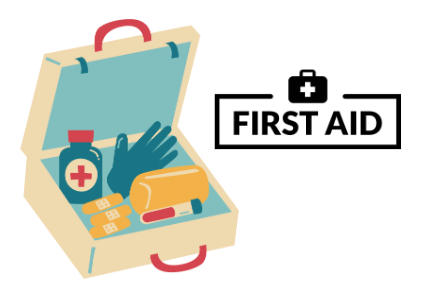 You provided first aid and made Tina feel better." Tina, feeling relieved, thanked Aman, saying, "Thank you, Aman! I'm feeling much better now." Aman's heart swelled with happiness as he realized the importance of knowing first aid and how it can help others in times of need.
You provided first aid and made Tina feel better." Tina, feeling relieved, thanked Aman, saying, "Thank you, Aman! I'm feeling much better now." Aman's heart swelled with happiness as he realized the importance of knowing first aid and how it can help others in times of need.
Basic Safety Precautions
Let's explore more about basic safety precautions and how to stay safe while helping others during accidents!
- Understand why first aid is crucial in emergencies.
- Learn how to treat small injuries like cuts and bruises.
- Always keep a first aid kit handy.
- Practice staying calm during an accident.
- Know when to call for help if the injury is serious.
Why is Safety Important?
Safety is crucial because it shields us from harm and accidents. Here are some reasons why safety is essential:
- To Avoid Danger: Safety rules help us steer clear of risky situations that could lead to harm.
- To Prevent Accidents: Following safety regulations ensures we stay injury-free in our daily activities.
- To Protect Ourselves and Others: Being cautious keeps not only us safe but also those around us.
- To Understand the Importance of Safety: Safety is vital for preventing injuries and promoting well-being.
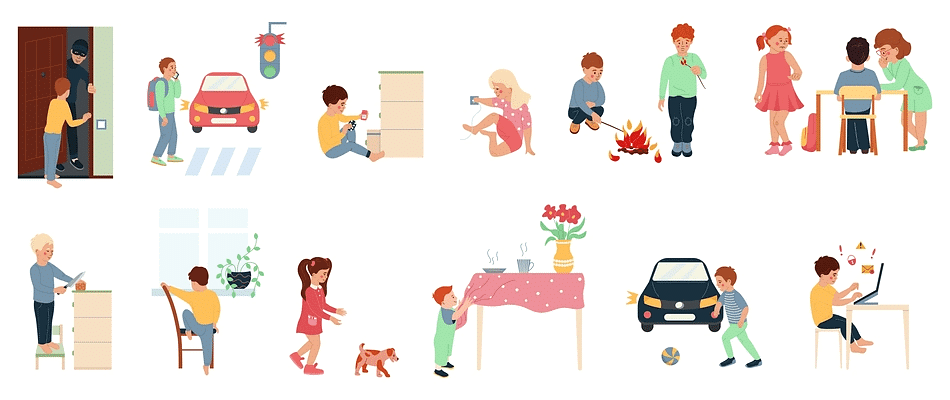
Safety rules vary depending on the places we visit, such as school, home, roads, and playgrounds. By following these rules, we can stay safe no matter where we are.
Safety at Home
Following a few simple safety rules can keep us safe at home.
- Fire and Electrical Safety: Never play with fire or light firecrackers by yourself. Always use matchsticks in the presence of an adult, and make sure to put them out before throwing them in a bin. Do not try to put your fingers into a plug point. Avoid touching damaged electric wires and tell an adult so they can replace them.
- Kitchen Safety: In the kitchen, always be cautious of the stove, hot utensils, and the food cooking. Stay away from the stove when it is on.
- Sharp Objects Safety: Knives, scissors, and tools are sharp and can cause cuts. They should be used very carefully, and do not play with sharp objects.
- Poisonous Substances: Do not taste anything you are not sure about. Many items, including some medicines, may be harmful for you.
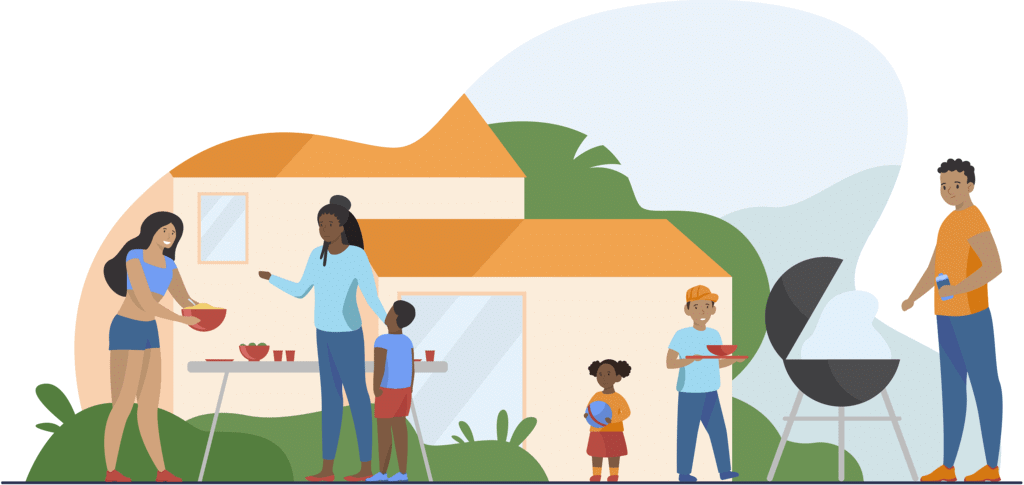
Safety at School
You can save yourself from accidents at school by behaving responsibly and following the rules.
Important Safety Tips
- Running inside the classroom and climbing on desks can lead to accidents. The corners of desks are sharp and can cause serious injuries.
- Be careful when using the stairs. Never run or push anyone. Falling on the stairs can result in serious injuries.
- When entering the science laboratory, exercise extreme caution. Never touch, taste, or smell anything without your teacher's permission.
- Blades are not for your use. Do not use them to sharpen pencils.
Basic First Aid Knowledge
Knowing basic first aid for common injuries is important. Schools should have essential first aid supplies, including:
- Adhesive bandages
- Gauze pads and adhesive tape
- Antiseptic wipes
- Scissors
- Tweezers
- Cold packs
- Emergency contact numbers
Safety on the Road
- Playing on the roads is very risky and dangerous.
- Footpaths are for walking. If there is no footpath, walk on the edge of the road and be careful of traffic.
- If you ride a bicycle, always ride on the left side of the road. Use hand signals to show when you are turning. If you are in a car, always wear your seat belt.
- Cross the road only at the zebra crossing for pedestrians. Before crossing, look to your right, then to your left, and then to your right again. Only cross when it is clear. Be extra careful when there is no zebra crossing.
- Follow the traffic signals. A green light means go, a red light means stop, and a yellow light means get ready to stop.
- Always stand in line when getting on a bus to stay safe and avoid accidents.
- Many accidents happen when people try to get on or off. moving bus. Never try to do this.
- When riding a bicycle, always wear a helmet to protect your head.
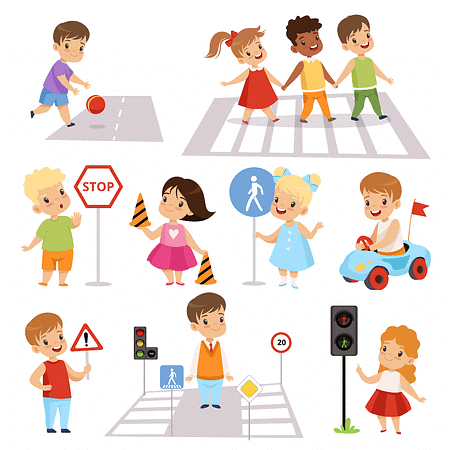
Safety on the Playground
- Sometimes, to win a match, players may start breaking the rules and playing roughly.
- It is important to always follow the rules of a game. They are important for safety and fair play.
- Playing games fairly and safely helps prevent accidents and makes the game fun for everyone.
- Do not push or trip others while playing to keep everyone safe.
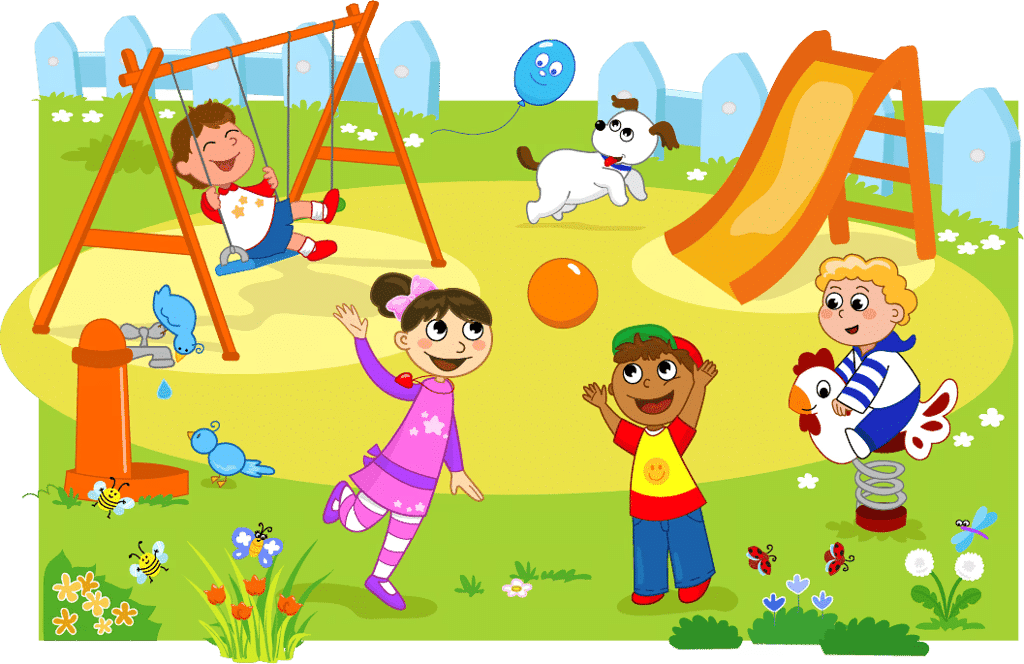
First Aid
- Stay Calm: When an accident happens, it's important to stay calm. You can help the injured person by following some simple steps. The help they need right away is called first aid.
- Find an Adult: Immediately try to find an adult to assist you.
- Keep People Away: Never let a crowd gather around the injured person.
- Don't Move The Injured Person: Avoid moving the injured person, especially if you suspect a broken bone, as this could cause more harm.
- Make Them Comfortable: Make sure the injured person is either seated or lying down comfortably.
- Treat Bleeding Wounds: If there is a bleeding wound, wash it with clean water.
- Bandage The Wound: Properly bandage the wound to stop the bleeding.
- Treat Burns: If someone has a burn, hold the burnt area under cold running water.
- Call For Help: Always call for medical help as soon as possible.
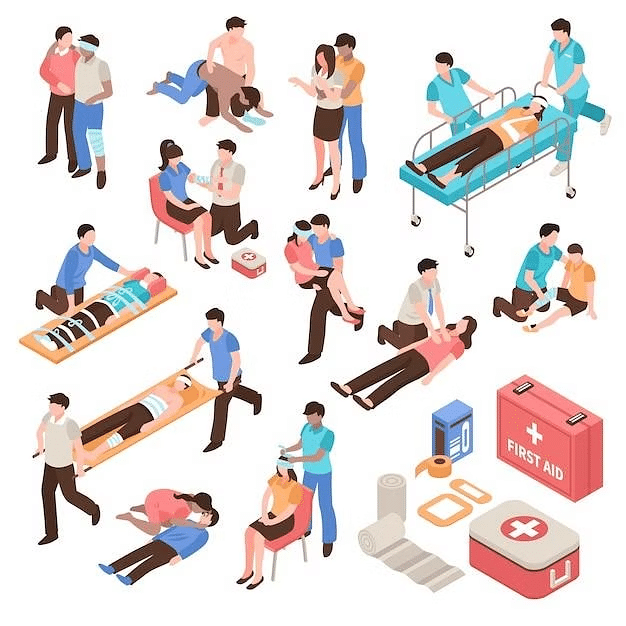
Home is Best
A home offers us safety from various things like weather, animals, and harmful things. Some features are important for a healthy life. So, our home should be made and taken care of with these important things in mind.
A Good Home
- Sunlight is important because it kills germs. There should be windows placed in a way that allows sunlight to come in.
- It’s important to have windows and ventilators to bring in fresh and clean air.Also, planting trees and plants around the house helps to clean the air.
- Open spaces like verandas or balconies are needed for getting sunshine and fresh air.
- Wire netting on doors and windows can keep insects like flies and mosquitoes out while allowing air and sunlight to come in.
- Cleanliness and hygiene are important in all parts of the house. A proper drainage system is important to keep bathrooms clean and dry by removing dirty water.
- Dirty water and garbage should not collect inside or outside the house, as this can bring insects and germs.
Care of the House
- Germs mainly grow in the kitchen, bathroom, and rubbish bins. These places should be cleaned properly every day.
- The rest of the house should also be cleaned daily.
- Flies and cockroaches should be kept out of the kitchen because they can spread diseases.
- Always make sure the food is covered.
- Make sure fresh air and sunlight can enter the kitchen and bathroom.
- Rubbish bins should be kept covered.
Conclusion
- Safety is a fundamental aspect of our lives that applies to various settings, including home, school, on the road, and during play.
- Adhering to simple safety rules is crucial for preventing accidents and ensuring the well-being of ourselves and others.
- First aid plays a vital role in providing assistance to others during emergencies.
- Remaining calm, acting swiftly, and seeking help from adults can significantly impact life-saving situations.
- A clean and well-maintained home environment is essential for safeguarding our health and safety.
- Maintaining proper hygiene and cleanliness is essential to protect ourselves from diseases caused by germs.
- By being responsible, cautious, and mindful of safety measures, we can foster a secure environment for ourselves and those around us.
- It is important to remember that safety should always be a top priority!
|
20 videos|203 docs|32 tests
|
FAQs on Safety And First Aid - CBSE Notes
| 1. Why is safety important in our daily lives? |  |
| 2. What are some safety tips for the home? |  |
| 3. How can we ensure safety at school? |  |
| 4. What are the key rules for safety on the road? |  |
| 5. What should be included in a basic first aid kit? |  |





















